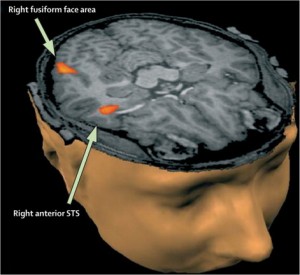Meeting Brad Pitt: A look inside a celebrity’s face-blindness
The first time you meet Brad Pitt, you might say you were star-struck, and that he was friendly and down to earth, especially considering his immense fame and position of power.

Meeting Brad Pitt for the first time may be comfortable and enjoyable for both parties. (Link to photo)
You may even have an hour-long conversation with him about his role in the film Fury in which Pitt plays a U.S. Army sergeant and commander of a tank in Nazi Germany during the end of World War II. During this conversation you share with him that your late grandfather commanded a tank in World War II and that you found the movie to be helpful in understanding what he went through. When your conversation is over, you may return home and tell your friends and family all about your wonderful experience with Brad Pitt.
A month later you see Brad Pitt again, give him a smile and a wave, and he stares back at your blankly, his face conveying confusion and you realize he has no idea who you are or why you are waving at him.

Meeting Brad Pitt for the second time, he may not recognize you and stare at you blankly. (Link to photo)
Your excitement of seeing him for the second time quickly disintegrates as he retracts his gaze and becomes enveloped by a sea of paparazzi and fans.
What could explain Pitt’s striking forgetfulness? Prosopagnosia.
Prosopagnosia, also known as face blindness, is a neurological disorder in which the ability to recognize previously familiar faces is impaired. Individuals with this disorder retain fully functioning memory, vision and learning abilities. Prosopagnosia is believed to selectively affect facial recognition rather than object recognition as a whole. In other words, individuals with prosopagnosia have demonstrated the ability to recognize non-facial objects they have previously been exposed to such as books or chairs. For this reason, these individuals often rely on non-facial information, for example voices, to recognize people they have previously met.
In a 2013 interview with Esquire, Pitt explained that the faces of people he meets begin to fade from his memory the moment the person walks away. Any attempt of his to hold onto the details of the face becomes futile as the facial features slip from his memory, disallowing him from recognizing that person the next time he encounters them. This facial recognition lapse has led people to feel that Pitt is disrespecting them, and have responded with, ‘you’re being egotistical,’ or ‘you’re being conceited.’
In the same interview, Pitt outlined his previous attempts to mediate the issues brought on by his face blindness. One year, rather than pretending to remember the person, he would ask where they met, or how they know each other, however, Pitt found that this approach was even more offensive to those he encountered. After trying this experiment and experiencing its negative consequences, Brad Pitt expressed that he no longer enjoys going out. He confesses that his face blindness even discourages him from leaving his home. However, Brad Pitt is a celebrity whose fame and distinction lends him to the role of a public person, often finding himself in large crowds and meeting new people who he may or may not meet again.
Brad Pitt is constantly meeting new people, but soon after these photos were taken, the mental images of their faces were likely erased from his mind.
Link to photo 1 Link to photo 2 Link to photo 3 Link to photo 4
What’s the truth?
Prosopagnosia is believed to result from abnormalities or impairment in the right fusiform gyrus, which is an area of the brain that has been shown to have a strong correlation with facial perception and memory.

The top arrow points to the right fusiform face area, the area thought to be highly connected with face recognition and consequently impaired in individuals with prosopagnosia. (Link to photo)
Several studies have shown that this area, also known the fusiform face area or FFA, is highly active when individuals are viewing faces that are familiar to them. While in some cases, prosopagnosia has been present from birth through adulthood, in other cases it appears to develop later in the individual’s life. Some cases of prosopagnosia appear to run in families and therefore may be the result of a genetic mutation or deletion. So, what about the case of Brad Pitt? Has he been suffering from prosopagnosia since birth? Did he develop the disorder in adulthood? In fact, we may never know the answer to the questions, or even be able to conclude whether he has prosopagnosia at all! It is possible that Brad Pitt uses this as an excuse to justify his lapses in kindness and memory. Pitt claims to have the disorder but has never been diagnosed with it. After being questioned about this issue of his, Pitt usually concludes by saying, ‘I am going to get it tested’. So, until he officially gets tested for prosopagnosia and the results of his testing are publicized, we may not know whether Brad Pitt is a kind man suffering from a facial recognition disorder or a rude man claiming to have one.
Citations:
Ward, Jamie. The Student’s Guide to Cognitive Neuroscience. 3rd ed. Hove, East Sussex: Psychology, 2010. Print.
http://www.ninds.nih.gov/disorders/prosopagnosia/Prosopagnosia.htm
http://www.medicaldaily.com/brad-pitt-says-he-has-face-blindness-prosopagnosia-more-common-thought-246184
http://www.medpagetoday.com/celebritydiagnosis/39420
http://www.esquire.com/entertainment/movies/interviews/a22679/brad-pitt-cover-interview-0613/




